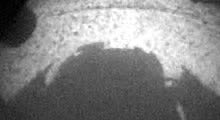
The Curiosity rover, the one-tonne exploration vehicle from the US space agency NASA, has touched down on Mars, landing in a deep crater near the planet’s equator at 06:32 BST.
Curiosity will now spend the next two years or more looking for evidence that the Red Planet could have supported life in the past. A signal confirming the rover had landed safely was relayed to Earth via NASA’s Odyssey satellite, which is in orbit around the planet, with the grainy low resolution pictures greeted with cheers in mission control at the Jet Propulsion Laboratory in Pasadena, California and across the world. A first colour image of Curiosity’s surroundings should be returned in the next couple of days.
The descent to landing was not without nerve-biting moments, however, with the descent through the Mars atmosphere after a 570 million kilometre journey from Earth ending in the “seven minutes of terror” as the lander had to complete a number of risky and simultaneous manoeuvres that would reduce its speed from 20,000km/h to 0.6m/s (around 2km/h) to set its wheels down on the foreign planet.
The Curiosity team had to wait thirteen minutes for the signals confirming these manoeuvres back to earth, such are the distances involved and the speed of light.
As the rover landed, NASA administrator Charles Bolden said
“We’re on Mars again, and it’s absolutely incredible,” said Nasa administrator Charles Bolden. “It doesn’t get any better than this.”
Curiosity’s mission on Mars is to investigate the central mountain inside Gale Crater. It will climb the 5km peak and analyse rocks that are billions of years old and laid down in the presence of liquid water looking for evidence of previous microbial life.
Unlike previous Mars missions, however, Curiosity will be exploring at a gentle pace due to its plutonium battery replaces the solar panels on previous vehicles. This means that whilst previous Mars rovers had only about a month to perform their tasks, Curiosity is prepared and funded for a two-year mission, with a strong chance that the mission will be extended after this period.

